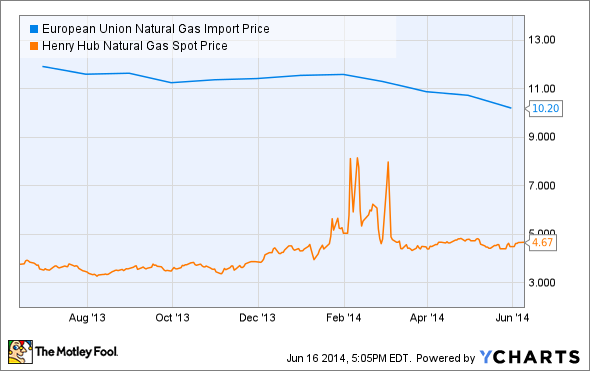





Popular Posts: 9 Cheap Stocks to Buy Now for $10 or Less11 Best Cheap Stocks Under $10 to Buy Now10 Cheap Stocks to Buy Under $10 Recent Posts: Newly Blue: 5 Blue-Chip Stocks to Buy 5 Hot Stocks Getting Their Momentum Back 5 Robot Stocks to Buy View All Posts Newly Blue: 5 Blue-Chip Stocks to Buy
The broadest definition of a blue-chip stock is a large company with a market capitalization of many billions that is also the market leader in its sector and a big-time name.

Source: Flickr
To some, the term "blue chip" also comes with a certain risk profile — a company that has been around for a long time, pays a dividend and is stable even in the worst of times. Think picks like Procter & Gamble (PG) and Coca-Cola (KO).
But blue chip investors don't have to be limited to the same stodgy list of companies. After all, there are a bunch of companies that have grown explosively over the past decade or two and have carved out a very comfortable and established niche and a massive market size.
Even if they haven't been around for a hundred years, I think these picks still qualify as blue-chip stocks to buy based on their dominance, dividend and stability.
So if you're looking for blue chip stocks to buy, consider these new members of the club:
Blue-Chip Stocks to Buy: Starbucks (SBUX)
 McDonald's (MCD) is a blue chip stock in the eyes of many investors, and it's time to add Starbucks (SBUX) to the list of stable dividend players who operate in the restaurant space.
McDonald's (MCD) is a blue chip stock in the eyes of many investors, and it's time to add Starbucks (SBUX) to the list of stable dividend players who operate in the restaurant space.
SBUX stock has traded publicly for more than 20 years, and currently boasts an impressive market capitalization of $56 billion — right in the ballpark of General Motors (GM) and Prudential (PRU).
And while Starbucks only recently began paying dividends four years ago, its dividend growth has been amazing. Payouts are up 160% from 10 cents per share quarterly in 2010 to 26 cents currently. That might only translate to a 1.4% yield, but at only 40% of this year's earnings, that leaves plenty of room for future growth.
As for stability, Starbucks continues to expand its brand globally and is as entrenched as any restaurant in the U.S. Also the company has just $2 billion in debt and liabilities just shy of $3 billion — an amazing balance sheet for a company this size, and particularly one in the restaurant sector.
Oh yeah, and SBUX is sitting on $1.7 billion in cash and short-term investments.
While you may not think of Starbucks first when you think of blue-chip stocks to buy, give this coffee king a look. Because the stability and dividends are certainly there — and will be there in the years to come.
Blue-Chip Stocks to Buy: Intel (INTC)
 Growing up in the computer age and only seriously investing in the 2000s, I have always thought of Intel (INTC) as a blue-chip stock, even while older investors scoff at the notion.
Growing up in the computer age and only seriously investing in the 2000s, I have always thought of Intel (INTC) as a blue-chip stock, even while older investors scoff at the notion.
I mean, the company has a $148 billion market cap right now — bigger than Citigroup (C) and on par with Bank of America (BAC) — and it has traded publicly since the 1970s. INTC also boasts a 3.2% yield with a 20-year history of payouts and impressive dividend growth.
So … why is this not already widely accepted as a blue chip stock?
Sure, in the 2000s there was the dot-com hangover, and recently there has been hype about a "post-PC age." However, talk about the rise of e-commerce doesn't mean that Wal-Mart (WMT) must cancel its dividend and get summarily booted from the Dow Jones Industrial Average.
Intel is evolving with the times. And heck, even if it doesn't, there is zero chance of its entire semiconductor business evaporating overnight. Intel remains the No. 1 chipmaker in the world with a roughly 15% market share according to research firm IHS.
It may be a tech stock, and it may be facing risks right now. But Intel is assuredly a low-risk, dividend-paying blue chip that will survive no matter what the market throws its way.
Blue-Chip Stocks to Buy: China Mobile (CHL)
 To some investors, only stocks in developed markets qualify as blue chip-stocks. And to others, even stocks like Swiss consumer giant Nestle (NSRGY) don't count because they are headquartered overseas.
To some investors, only stocks in developed markets qualify as blue chip-stocks. And to others, even stocks like Swiss consumer giant Nestle (NSRGY) don't count because they are headquartered overseas.
However, we live in the age of globalization, and that kind of thinking is a bit naïve. After all, how is Chevron (CVX) all that much different than Royal Dutch Shell (RDS.A) because they are headquartered on different continents?
The next geographic step for blue chip stocks, then, is to go beyond Europe and even into some major emerging markets where the stocks there are even more entrenched than their American peers.
One stock that fits this bill is Chinese telecom China Mobile (CHL), a massive company worth about $200 billion that commands over 750 mobile subscribers — twice the population of the entire united states!
You don't get much more entrenched than that.
Furthermore, look at these dividend stats for CHL:
Current dividend yield: 4.4% (based on its total 2013 payouts of roughly $2.01) Dividend payout ratio: 41% of projected 2014 earnings Dividend growth: 550% in 10 years, from 30.8 cents per share in 2003 to $2.01 last year
Sure, China Mobile is still growing as rural China continues to get connected. However this stock is already so huge that even adding a few million extra subscribers here and there doesn't really move the needle dramatically on a percentage basis.
There is assuredly risk to all China stocks, but investors can take heart in the fact that CHL has largely been rangebound between $40 and $60 per share since the end of 2008 — and is currently in the middle of those bounds at just shy of $50 per share.
Don't be fooled by the China hype. CHL has stability, a robust dividend and blue chip status despite its presence in this emerging market.
Blue-Chip Stocks to Buy: Visa (V)
 Visa (V) certainly meets the standard of a household name, with this company at the center of the credit card industry for decades. But to many investors, Visa is simply too young to trust with blue-chip stocks status because it only went public in 2008.
Visa (V) certainly meets the standard of a household name, with this company at the center of the credit card industry for decades. But to many investors, Visa is simply too young to trust with blue-chip stocks status because it only went public in 2008.
That's just plain silly. Visa is a $130 billion company that operates in 200 countries and has been at the forefront of payments processing since it was created in the mid-1970s. The company's brand is synonymous with credit cards, Visa has deftly branched out into emerging markets and leadership continues to forge ahead with mobile payments to find even more growth in a digital age.
What's not "blue-chip" about Visa, aside from its relatively short presence on the NYSE?
Visa pays an admittedly disappointing dividend of just 0.8%, however the company has paid distributions since shortly after its IPO and has almost quadrupled payments from 10.5 cents quarterly to 40 cents currently. Furthermore, the dividend payout ratio is a highly sustainable 21% of earnings — and with those earnings consistently growing, the dividend should grow, too.
The stock is stable, the business is entrenched and the dividend has big upside … sounds like another winner on the list of blue-chip stocks to buy.
Blue-Chip Stocks to Buy: Cisco (CSCO)
 Some investors are happy to place the label of blue chip stock on IBM (IBM), but for some reason similar enterprise technology companies don't enjoy the same status in their eyes.
Some investors are happy to place the label of blue chip stock on IBM (IBM), but for some reason similar enterprise technology companies don't enjoy the same status in their eyes.
That's nonsense. Even though IBM is (ostensibly) over 100 years old, a company like Cisco (CSCO) shouldn't be denied the same label just because it doesn't have the same age.
Consider that Cisco is worth over $125 billion in market capitalization, and has operated since the 1980s. Oh yeah, and after Citigroup (C) and General Motors (GM) were booted from the Dow Jones Industrial Average thanks to the financial crisis, they were replaced by this relatively young tech stock in the flagship stock market index.
And despite criticism in recent years about how the company foolishly chased consumer products like the Flip video camera and is losing out in the new era of tech, CSCO happened to be No. 1 in cloud computing infrastructure market share last quarter — beating out Hewlett-Packard (HPQ) and IBM.
Cisco only recently began paying dividends, starting in 2011. But those dividends have tripled in short order from 6 cents quarterly to 19 cents per quarter currently. That's good for a 3.1% yield.
Critics will say that CSCO stock has been very sleepy and has gone nowhere since its dot-com bust. But remember, blue-chip stocks are about stability and not explosive moves. The slow-and-steady nature of Cisco for the last 10 years actually proves pretty well why this stock should be included in the conversation of new blue chip stocks.
Jeff Reeves is the editor of InvestorPlace.com and the author of The Frugal Investor's Guide to Finding Great Stocks. As of this writing, he did not hold a position in any of the aforementioned securities. Write him at editor@investorplace.com or follow him on Twitter via @JeffReevesIP.

 As the United States and Germany prepare to compete in a World Cup match on Thursday in Brazil, some sports commentators are saying that the Europeans – ranked No. 2 at the tournament – may have the advantage over the U.S., ranked 13th.
As the United States and Germany prepare to compete in a World Cup match on Thursday in Brazil, some sports commentators are saying that the Europeans – ranked No. 2 at the tournament – may have the advantage over the U.S., ranked 13th.


 Popular Posts: Trade of the Day: Delta (DAL)An Online Payments Play With Big Opportunity … And It’s Not Amazon!Fortegra Stock Is a Winner For Patient Investors Recent Posts: 4 Utilities Stocks Powered by Solid Fundamentals Trade of the Day: Delta (DAL) An Online Payments Play With Big Opportunity … And It’s Not Amazon! View All Posts 4 Utilities Stocks Powered by Solid Fundamentals
Popular Posts: Trade of the Day: Delta (DAL)An Online Payments Play With Big Opportunity … And It’s Not Amazon!Fortegra Stock Is a Winner For Patient Investors Recent Posts: 4 Utilities Stocks Powered by Solid Fundamentals Trade of the Day: Delta (DAL) An Online Payments Play With Big Opportunity … And It’s Not Amazon! View All Posts 4 Utilities Stocks Powered by Solid Fundamentals  It will seemingly take a lot to break the current rally, as the market only bent under the weight of political unrest in Iraq and the resulting higher oil prices yesterday. And stocks also largely shook off the disappointment of weaker-than-expected May retail sales.
It will seemingly take a lot to break the current rally, as the market only bent under the weight of political unrest in Iraq and the resulting higher oil prices yesterday. And stocks also largely shook off the disappointment of weaker-than-expected May retail sales. Consolidated Water (CWCO) is a utility with some innovative technology in its pursuit to treat and provide water in parched areas.
Consolidated Water (CWCO) is a utility with some innovative technology in its pursuit to treat and provide water in parched areas. NRG Energy (NRG) is the second-largest independent retail energy provider in the United States. The company boasts more than 2 million customers thanks to some recent acquisitions.
NRG Energy (NRG) is the second-largest independent retail energy provider in the United States. The company boasts more than 2 million customers thanks to some recent acquisitions. Covanta (CVA) is not tied to any of the instantly recognizable areas of greentech, such as solar or wind, but it still operates right in that niche. The company quite literally turns trash into treasure — or in this case, energy.
Covanta (CVA) is not tied to any of the instantly recognizable areas of greentech, such as solar or wind, but it still operates right in that niche. The company quite literally turns trash into treasure — or in this case, energy. EnerNOC (ENOC) is a play on the intersection between technology and energy. ENOC is a relatively small tech firm ($560 million market cap), and it operates in two revenue segments, providing what is known as “demand response” services to utilities and “energy management” services to enterprises. The biggest segment by far is utilities, which brings in 90% of revenue, while the remaining 10% comes from enterprises.
EnerNOC (ENOC) is a play on the intersection between technology and energy. ENOC is a relatively small tech firm ($560 million market cap), and it operates in two revenue segments, providing what is known as “demand response” services to utilities and “energy management” services to enterprises. The biggest segment by far is utilities, which brings in 90% of revenue, while the remaining 10% comes from enterprises. Popular Posts: 2 Top Travel Stocks Trading Under $102 Chinese Internet Stocks to Buy Today – QIHU, YYAMZN: Amazon Stock Price May Already Be in Its Prime Recent Posts: Under Armour Stock Split Heats Up UA Even More 13 Lucky Stocks To Buy On Dips YHOO: Yahoo Stock Is More Than Just Alibaba Bounce View All Posts
Popular Posts: 2 Top Travel Stocks Trading Under $102 Chinese Internet Stocks to Buy Today – QIHU, YYAMZN: Amazon Stock Price May Already Be in Its Prime Recent Posts: Under Armour Stock Split Heats Up UA Even More 13 Lucky Stocks To Buy On Dips YHOO: Yahoo Stock Is More Than Just Alibaba Bounce View All Posts 
 China’s chronic capital problem appears to be easing, which should boost the world’s second-largest economy and cheer emerging market investors.
China’s chronic capital problem appears to be easing, which should boost the world’s second-largest economy and cheer emerging market investors.


 Popular Posts: 9 Cheap Stocks to Buy Now for $10 or Less11 Best Cheap Stocks Under $10 to Buy Now10 Cheap Stocks to Buy Under $10 Recent Posts: Newly Blue: 5 Blue-Chip Stocks to Buy 5 Hot Stocks Getting Their Momentum Back 5 Robot Stocks to Buy View All Posts Newly Blue: 5 Blue-Chip Stocks to Buy
Popular Posts: 9 Cheap Stocks to Buy Now for $10 or Less11 Best Cheap Stocks Under $10 to Buy Now10 Cheap Stocks to Buy Under $10 Recent Posts: Newly Blue: 5 Blue-Chip Stocks to Buy 5 Hot Stocks Getting Their Momentum Back 5 Robot Stocks to Buy View All Posts Newly Blue: 5 Blue-Chip Stocks to Buy  Source: Flickr
Source: Flickr  McDonald's (MCD) is a blue chip stock in the eyes of many investors, and it's time to add Starbucks (SBUX) to the list of stable dividend players who operate in the restaurant space.
McDonald's (MCD) is a blue chip stock in the eyes of many investors, and it's time to add Starbucks (SBUX) to the list of stable dividend players who operate in the restaurant space. Growing up in the computer age and only seriously investing in the 2000s, I have always thought of Intel (INTC) as a blue-chip stock, even while older investors scoff at the notion.
Growing up in the computer age and only seriously investing in the 2000s, I have always thought of Intel (INTC) as a blue-chip stock, even while older investors scoff at the notion. To some investors, only stocks in developed markets qualify as blue chip-stocks. And to others, even stocks like Swiss consumer giant Nestle (NSRGY) don't count because they are headquartered overseas.
To some investors, only stocks in developed markets qualify as blue chip-stocks. And to others, even stocks like Swiss consumer giant Nestle (NSRGY) don't count because they are headquartered overseas. Visa (V) certainly meets the standard of a household name, with this company at the center of the credit card industry for decades. But to many investors, Visa is simply too young to trust with blue-chip stocks status because it only went public in 2008.
Visa (V) certainly meets the standard of a household name, with this company at the center of the credit card industry for decades. But to many investors, Visa is simply too young to trust with blue-chip stocks status because it only went public in 2008. Some investors are happy to place the label of blue chip stock on IBM (IBM), but for some reason similar enterprise technology companies don't enjoy the same status in their eyes.
Some investors are happy to place the label of blue chip stock on IBM (IBM), but for some reason similar enterprise technology companies don't enjoy the same status in their eyes.

 ) offers a dividend yield of 3.46% based on Wednesday's closing price of $37.03 and the company's quarterly dividend payout of 32 cents. The stock is up 13.97% year-to-date. Dividend.com currently rates PNY as “Neutral” with a DARS™ rating of 3.4 stars out of 5 stars.
) offers a dividend yield of 3.46% based on Wednesday's closing price of $37.03 and the company's quarterly dividend payout of 32 cents. The stock is up 13.97% year-to-date. Dividend.com currently rates PNY as “Neutral” with a DARS™ rating of 3.4 stars out of 5 stars.